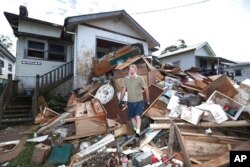Australian authorities were ill-prepared for recent record floods, according to a parliamentary inquiry into the response to the extreme weather. At least 10 people died when wild storms and unprecedented rainfall inundated parts of New South Wales and Queensland three months ago.
Thousands of residents were forced to flee their homes in eastern Australia and many towns were severely damaged. The disaster is one of the most expensive in Australia’s history. Insurance experts estimate damages will likely exceed $3 billion.
Weather analysts have said the floods were caused in part by the La Nina weather pattern and were exacerbated by climate change.
Tony Davies, head of the Australian charity Social Futures, says many residents are living in appalling conditions.
“There are people in hotels still. There are people who are camping and there are increasing numbers of people going back into houses that are pretty much a roof and perhaps some external walls," said Davies. "But really, they are camping inside a structure that has no walls inside, no facilities.”
In the city of Lismore, north of Sydney, a flotilla of private boats and jet skis rescued stranded residents because the authorities were ill-prepared. Government agencies in Australia have been criticized for their slow response to the crisis at an official inquiry.
In March, the New South Wales state government commissioned an independent expert investigation into the way the disaster was handled by official bodies. It will consider a raft of issues, including planning rules for development in flood-prone areas.
New South Wales Premier Dominic Perrottet says many state agencies did not respond properly when the community needed help.
“I have seen firsthand and, you know, dealt with many people who have heartbreaking stories who have lost everything," Perrottet said. "And a lot of that has to be attributed to the mistakes of governments in the past.”
Australia’s Bureau of Meteorology has forecast more wet conditions for coming months.It predicts that large parts of eastern, central and northern Australia will have “unusually high rainfall” for June to August, which will increase the risk of more flooding.
Scientists warn global warming is making Australia more vulnerable to extreme weather events. These fears are shared by its Pacific neighbors, which have said climate change is an existential threat to their communities and could likely trigger more severe storms, catastrophic floods and rising sea levels.
Australia and the Pacific are accustomed to nature’s volatility, but recent floods and storms have convinced many people that climate change is not a hypothetical future problem but something that is already happening.










